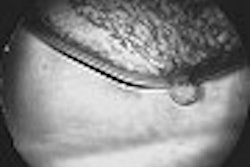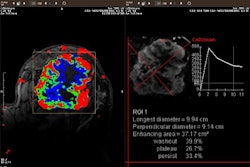SAN FRANCISCO - When it comes to mammograms, it’s relatively easy to obtain the images; it’s the interpretation of those images that can be tricky. With breast ultrasound, the opposite holds true, explained Cindy Rapp during a presentation Friday at the Current Trends in Breast Ultrasound meeting, sponsored by the American Institute of Ultrasound in Medicine.
Reading a properly scanned ultrasound is less daunting, but the key is proper scanning techniques and algorithms, both of which are heavily dependent on the skill of the operator, said Rapp, who is a breast sonographer at Radiology Imaging Associates, Sally Jobe Breast Center, in Greenwood Village, CO.
Rapp shared ways to enhance breast sonography, including the indications for using ultrasound for breast imaging, how to make the most of the equipment, patient positioning, and system optimization.
Indications
Rapp stressed that breast ultrasound should be used as an adjunct to mammography. In fact, "you always want to (have) the mammogram (for comparison) before you do the ultrasound. I’m not saying that ultrasound is here to replace mammography," she said. "But patients are asking for it…I tell them that mammography is still your best screening modality, but ultrasound can be beneficial in some patients."
As it is a diagnostic tool, breast ultrasound should be targeted to specific clinical or focal mammographic findings. The modality also is useful for gaining more information about palpable lumps when the mammogram is nonspecific. Ultrasound also has value for guiding biopsies and other interventional procedures.
Equipment
Successful breast ultrasound requires good spatial and contrast resolution. More specifically, the axial and lateral components of spatial resolution must be up to par.
The axial resolution is important for identifying normal structures, which run a course parallel to the skin, as well as cyst and solid-nodule characterization. The lateral resolution is vital in order to minimize volume averaging of surrounding normal breast tissue with pathological lesions, Rapp said. Volume averaging can result in mischaracterization of small cystic lesions as solid.
Coded harmonics can fine-tune contrast resolution by reducing artifacts, reducing echoes within cysts, increasing echogenicity, and increasing the conspicuity of sold lesions. At a study done at her institution, a change was made in BI-RADS category 3 and 4 lesions 24% of the time because of clearer information.
However, the disadvantages of coded harmonics include a lower frame rate and lower penetration, Rapp cautioned. Also, it may not be suitable for patients with larger breasts.
Using a real-time compounding feature can decrease artifactual echoes and acoustic shadowing, decrease edge shadows, define lesion or cyst capsules, and reduce speckle.
With compounding, more of the true lesion size can be seen, Rapp explained.
Currently, broadband high-frequency linear-array probes (7.5-13 MHz transducer with a 1.5-cm elevation plane) offer the best combination of spatial and contrast resolution, Rapp said.
"Unfortunately, I don’t think there’s a machine out there with both (real-time compounding and coded harmonics) features. In many cases, real-time harmonics is only available on top-of-the-line machines," she added.
Patient positioning
Another key to garnering worthwhile breast ultrasound results is to flatten the tissue planes out as much as possible, Rapp said. The goal is to adequately penetrate the chest wall and optimize the focus of a high-frequency near-field probe.
All solid lesions should be scanned in the plane of the ductal system (radial and anti-radial) in order to catch subtle projections that either course toward the nipple or outward in the breast.
When doing a comparison of mammograms and breast sonograms, make sure that the size, shape, location, and surrounding tissue density match up. Rapp emphasized that when it comes to shape, there is 90° rotational difference between the two modalities. As a result, a lesion that is perpendicular (in the breast) on a mammogram will be parallel on the ultrasound, she said.
As for imaging palpable lesions, Rapp pointed out that "the only ones that patients palpate are perfectly round and under tension." When imaging these lumps, Rapp advocated using simultaneous palpation and scanning in order to achieve correct placement, and not a stand-off pad.
"Take your finger and run it under the transducer," she said. "The number one palpable abnormality is normal fibroglandular tissue."
System optimization
Correct equipment settings can make all the difference in breast ultrasound. For example, if the gain is not set correctly, solid lesions can look cystic. Rapp recommended that before scanning the area of interest, find another area within the breast with fatty tissue. Make sure that the fat is set to medium gray and compare all lesions in the breast to the fat, she said.
"All breast cancer does not shadow," she added. "If all the fat is black, you could have solid lesions that look like cysts."
If the gain is set and fat is at medium gray, glandular tissue and fibroadenomas appear isoechoic to mildly hypoechoic on ultrasound, whereas malignant lesions can be markedly hypoechoic. Cysts are markedly hypoechoic to anechoic.
"Make sure your fat is set to medium gray," Rapp stressed again. "We compare everything to fat."
One serious mistake that novice breast sonographers may make is to scan with too little pressure, Rapp said. Pressure is crucial to separating normal tissue from possible lesions or other problems. Not enough pressure also can result in shadowing that may only be an artifact.
"I can take perfectly normal tissue and make it look like a cancer just by scanning with too light pressure," Rapp said. "Ultrasound is a wonderful tool, but it can be dangerous if you don’t know how to use it."
By Shalmali Pal
AuntMinnie.com staff writer
August 25, 2003
Related Reading
Breast US expert reiterates modality’s role as adjunct to mammography, July 11, 2003
Breast cancer in younger women calls for flexibility in imaging, May 2, 2003
Proving breast cancer screening efficacy remains complex, January 10, 2003
Ultrasonography improves cancer screening of dense breasts, September 20, 2002
Copyright © 2003 AuntMinnie.com



















